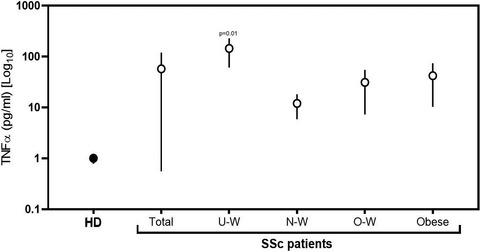当前位置:
X-MOL 学术
›
Clin. Exp. Immunol.
›
论文详情
Our official English website, www.x-mol.net, welcomes your
feedback! (Note: you will need to create a separate account there.)
Body mass index and adipokines/cytokines dysregulation in systemic sclerosis
Clinical & Experimental Immunology ( IF 3.4 ) Pub Date : 2021-08-06 , DOI: 10.1111/cei.13651 Florenzo Iannone 1 , Emanuela Praino 1 , Cinzia Rotondo 2 , Dorotea Natuzzi 1 , Rita Bizzoca 1 , Nunzia Lacarpia 1 , Marco Fornaro 1 , Fabio Cacciapaglia 1
Clinical & Experimental Immunology ( IF 3.4 ) Pub Date : 2021-08-06 , DOI: 10.1111/cei.13651 Florenzo Iannone 1 , Emanuela Praino 1 , Cinzia Rotondo 2 , Dorotea Natuzzi 1 , Rita Bizzoca 1 , Nunzia Lacarpia 1 , Marco Fornaro 1 , Fabio Cacciapaglia 1
Affiliation

|
Body fat has regulatory functions through producing cytokines and adipokines whose role in the pathogenesis of systemic sclerosis (SSc) is currently emerging. Changes in body mass, either over- or underweight, entail a dysregulation of the cytokine/adipokine network that may impact upon SSc disease activity. We evaluated serum levels of adipokines and cytokines in SSc patients and correlated them to clinical features and body mass index (BMI) categories. The study included 89 SSc patients and 26 healthy donors (HD). Serum levels of adiponectin, leptin, resistin, visfatin, tumor necrosis factor (TNF)-α, interferon (IFN)-γ, interleukin (IL)-2, IL-10 and IL-17A were measured by multiplex immunoassay and correlated to BMI and disease-specific features. Student’s t-test or analysis of variance (ANOVA) were used for comparisons between groups. Spearman’s or Pearson’s tests were used for correlation analysis. Serum levels of TNF-α, IL-2, leptin and resistin were significantly higher in SSc than in HD. Leptin levels were significantly higher in interstitial lung disease (ILD)- and pulmonary arterial hypertension (PAH)-SSc subgroups. The highest levels of IL-17A, IL-2, IL-10, leptin and visfatin were detected in SSc patients with obesity (p < 0.01). Conversely, underweight SSc patients showed the highest TNF-α levels (p < 0.05). Adipokines, IL-2, IL-10 and IL-17A were found to be increased in SSc patients with obesity, but whether or not they play a role in the pathogenesis of the disease remains to be investigated. Intriguingly, underweight patients had the highest TNF-α levels, suggesting a potential role of TNF-α in inducing the cachexia observed in long-lasting disease.
中文翻译:

系统性硬化症中的体重指数和脂肪因子/细胞因子失调
体脂肪通过产生细胞因子和脂肪因子具有调节功能,它们在系统性硬化症 (SSc) 的发病机制中的作用目前正在显现。体重的变化,无论是超重还是过轻,都会导致细胞因子/脂肪因子网络失调,这可能会影响 SSc 疾病活动。我们评估了 SSc 患者的血清脂肪因子和细胞因子水平,并将它们与临床特征和体重指数 (BMI) 类别相关联。该研究包括 89 名 SSc 患者和 26 名健康供体 (HD)。脂联素、瘦素、抵抗素、内脂素、肿瘤坏死因子 (TNF)-α、干扰素 (IFN)-γ、白细胞介素 (IL)-2、IL-10 和 IL-17A 的血清水平通过多重免疫测定法测量并与 BMI 相关联和疾病特异性特征。学生的t-检验或方差分析(ANOVA)用于组间比较。Spearman 或 Pearson 检验用于相关性分析。SSc 中 TNF-α、IL-2、瘦素和抵抗素的血清水平显着高于 HD。间质性肺病 (ILD) 和肺动脉高压 (PAH) - SSc 亚组的瘦素水平显着升高。在患有肥胖症的 SSc 患者中检测到最高水平的 IL-17A、IL-2、IL-10、瘦素和内脂素(p < 0.01)。相反,体重不足的 SSc 患者显示出最高的 TNF-α 水平(p < 0.05)。发现脂肪因子、IL-2、IL-10 和 IL-17A 在患有肥胖症的 SSc 患者中增加,但它们是否在该疾病的发病机制中发挥作用仍有待研究。有趣的是,体重不足的患者的 TNF-α 水平最高,这表明 TNF-α 在诱导长期疾病中观察到的恶病质方面具有潜在作用。
更新日期:2021-10-12
中文翻译:

系统性硬化症中的体重指数和脂肪因子/细胞因子失调
体脂肪通过产生细胞因子和脂肪因子具有调节功能,它们在系统性硬化症 (SSc) 的发病机制中的作用目前正在显现。体重的变化,无论是超重还是过轻,都会导致细胞因子/脂肪因子网络失调,这可能会影响 SSc 疾病活动。我们评估了 SSc 患者的血清脂肪因子和细胞因子水平,并将它们与临床特征和体重指数 (BMI) 类别相关联。该研究包括 89 名 SSc 患者和 26 名健康供体 (HD)。脂联素、瘦素、抵抗素、内脂素、肿瘤坏死因子 (TNF)-α、干扰素 (IFN)-γ、白细胞介素 (IL)-2、IL-10 和 IL-17A 的血清水平通过多重免疫测定法测量并与 BMI 相关联和疾病特异性特征。学生的t-检验或方差分析(ANOVA)用于组间比较。Spearman 或 Pearson 检验用于相关性分析。SSc 中 TNF-α、IL-2、瘦素和抵抗素的血清水平显着高于 HD。间质性肺病 (ILD) 和肺动脉高压 (PAH) - SSc 亚组的瘦素水平显着升高。在患有肥胖症的 SSc 患者中检测到最高水平的 IL-17A、IL-2、IL-10、瘦素和内脂素(p < 0.01)。相反,体重不足的 SSc 患者显示出最高的 TNF-α 水平(p < 0.05)。发现脂肪因子、IL-2、IL-10 和 IL-17A 在患有肥胖症的 SSc 患者中增加,但它们是否在该疾病的发病机制中发挥作用仍有待研究。有趣的是,体重不足的患者的 TNF-α 水平最高,这表明 TNF-α 在诱导长期疾病中观察到的恶病质方面具有潜在作用。











































 京公网安备 11010802027423号
京公网安备 11010802027423号